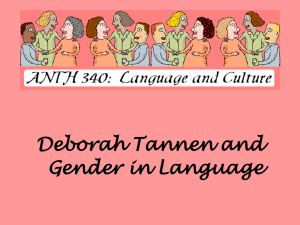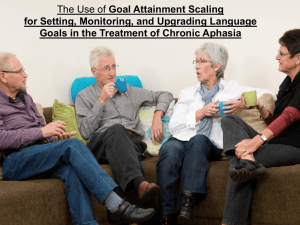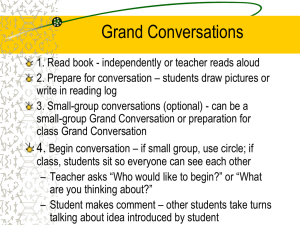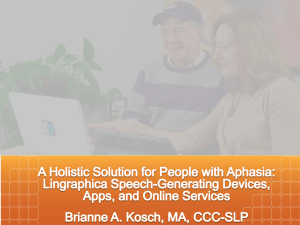Developing Supported Conversation across the Trust
advertisement
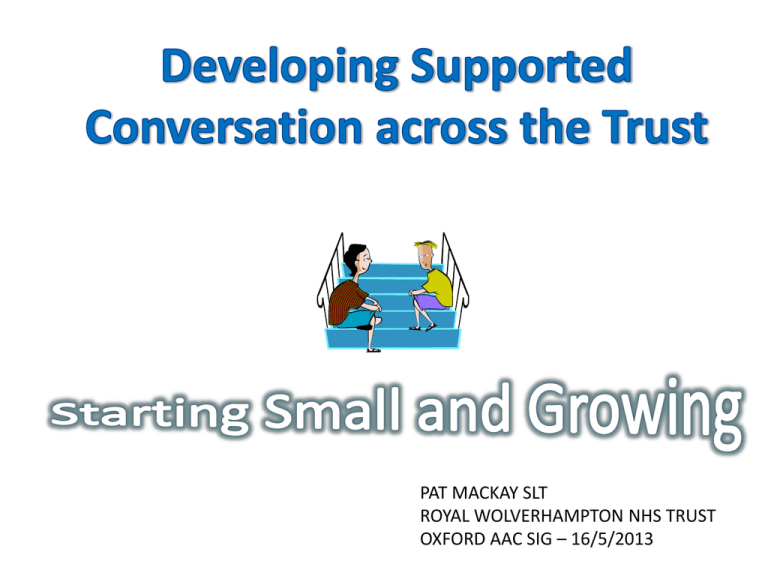
PAT MACKAY SLT ROYAL WOLVERHAMPTON NHS TRUST OXFORD AAC SIG – 16/5/2013 Supported Conversation training in Wolverhampton • Connect Website • 2004 – needed change/alternative to impairment based therapies • Already involving training for families/ carers/staff – information giving • New stroke guidelines (2004) • Alex Stirling – Changing Attitudes to Conversation in an Acute Setting • Aura Kagan (1989) describes supported conversation as a method where “The partner acts as a resource for the person with Aphasia and actively shares the communication load. Supported Conversation provides conversation partners with methods and materials for achieving this goal” Key ideas • • • • Acknowledge and reveal Competence Social, not medical model Equal responsibility in a conversation Conversation Props and Ramps message in and message out • Total communication environment Conversation Props and Ramps • • • • • Writing Gesture Drawing Pictures – magazines, newspapers, photos, Books, diaries, calendars, life books, SCA resource manual, relevant ‘remnant’ objects, initiators • Communication books/ Communication passports • NB other issues - taking turns, quiet surroundings, taking your time • Attended various Connect courses • Flesh on the bones of what we were trying to do FIRST STEPS! • Feedback and planning day ’05 • Brainstorming session – pros and challenges • Long and short term goals – actions PLAN OF ACTION • Training in Social Model approach SLTs, HCPs, expert patients • Training ourselves as trainers • User-friendly resources • Creating opportunities for carers to see props and ramps being used • Creating own life books • Enabling others to make life books • Politics • Groups – total communication (in and out patients) • SLT rooms more aphasia friendly WHAT WE DID! • • • • Devised training package Selected pilot base (neuro-rehab) Offered monthly Advertised with flyers and direct contact with relevant managers • Fitted in with mandatory nurse training • Opened it up to all hospital staff • Extended to acute hospital and the community • Adapted leaflets/hand-outs to be more aphasia friendly • Requested feedback from Functional Group (clients with aphasia) • Put up aphasia friendly signage around hospital • Wards provided with communication resource box (props and ramps) • Communication tips sheets at beds • Symbol based drinks/snack choices for drinks trolleys • Weekly In/out patient communication group (supported conversation focussed) Supported Conversation Speech & Language Therapy Wolverhampton City PCT 2012 Acknowledgements: Alex Stirling Carole Pound Aura Kagan Connect ‘Supported Conversation’ • Communication – what is it and why is it so important ? • What happens when it goes wrong ? • Supporting and helping communication • Practical session and feedback • Evaluation forms Communication……. • …….what does it involve ? Why do we communicate ? Think about different kinds of communication difficulties How would it feel if you couldn’t communicate ? How would it affect your life ? WHAT IS A CONVERSATION? • • • • • • • Two way Listening and talking Spontaneous, not planned Information exchange Opinions and ideas Fun, enjoyment, social connection Who you are Conversations and aphasia Just the same but ….. • Both people need to work harder • Both people need to be flexible and resourceful • Use strategies as well as speech • Allow time for the conversation • Give the person plenty of time Examples of good and bad conversations Watch the DVD Supporting and helping communication Message In - Message Out • Message In How we help someone understand our message • Message Out How we help someone get their message across Support Modes Drawing Writing things down Gesture/Pointing Pictures • helps get the message IN • helps hold the message • helps get the message OUT Feedback “I don’t feel so useless” (Rehab counsellor) “It made me really think about how I communicate with people who have aphasia .. Certainly take on board all the ideas.. Have learned a lot “ (OT) “I know what I should be doing now..” (counsellor) “I have found this very useful and will continue to practise and use these skills in my job” (enrolled nurse) “I feel more confident to converse with people who have communication difficulties” (HCA) “It made me think more about how I can communicate with people and how I need to give more time and patience” (Housekeeping assistant) What worked and what started well but faded… • Training ourselves as trainers • User-friendly resources - Adapted leaflets/handouts to be more aphasia friendly and put up aphasia friendly signage around hospital • Communication tips sheets at beds • Symbol based drinks/snack choices for drinks trolleys • Enabling others to make life books • Politics • Groups – supported conversation/total communication (in and out patients) • SLT rooms more aphasia friendly • Creating opportunities for carers to see props and ramps being used • Creating own life books • Opened it up to all hospital staff • Extended to acute hospital and the community • Wards provided with communication resource box (props and ramps) • Fitted in with mandatory nurse training • Previously using role modelling as practise • Now wanted to make it more realistic HOW? • 2 SLTs attended further Connect led training – Training the Trainers • Involved volunteers from around the region who have aphasia being trained to be involved in training Health Care Professionals • learn how to give useful feedback about how someone’s communication partner skills • invited to participate in SC training in the region • While first part of SC training is going on, SLT goes through Training the Trainers presentation to remind them/support them in what they previously learned Things to think about • • • • • • Travel arrangements Travel costs Payment? Physical access to training area/toilets etc Need more than 1 SLT for the SC training Inevitably a longer training session overall and so not suitable to fit into nurse mandatory training times • However, MUCH more effective!! Who to target? • • • • New SLTs AHPs in neuro rehab setting Nurses on stroke unit Early Supported Discharge team (AHPs plus rehab technicians) • Other staff in neuro rehab setting – dietician, clinical psychologist • Social workers linked with neuro team Changes to training • Longer than that offered during mandatory nurse training (3 hours) • Includes some practical time with trainers • “Try it for real!” – 15 minute conversation with someone who has a communication difficulty (plus an observer) – 5 minutes feedback on your conversational skills – Return to main group for summary and group discussion BUDDY PROJECT Supported Conversation Training for Buddy Volunteers Buddy Project • Supported Conversation Training for Buddy Volunteers • The stroke buddy scheme came about from an idea spoken about at the Stroke Conference • It is a way to try and help people who have had a stroke who are finding it difficult to take part in rehabilitation • These people were helped more by those who had had a similar experience than by professional staff • Draws on key concepts of Supported Conversation for Adults with Aphasia (Kagan, 1995) • New project in Wolverhampton – 2011 Stroke survivors volunteer to befriend & support other people who have had a stroke & who are having difficulty coming to terms with their difficulties & life changes • Team: – Speech & Language Therapist – Occupational Therapist – Clinical Psychologist – Volunteer + Buddy Our Role • Ensure involvement of People with communication difficulty as buddies. • Devise training packages for volunteers. • Help to develop aphasia friendly information to enable data collection pre/post project. • General planning and devising paperwork for the project. • Once the volunteers had received training about different communication difficulties, they were then trained in how to support communication, and this training is based on Kagan’s SCA approach – Supported conversation for adults with aphasia. The Role of the Volunteer • The contact might include: • Going round to their house, having a cup of tea and a chat • Helping them to get involved in things that interest them The overall aim is to gently encourage the buddy to do more for themselves, make the most of services and get more out of life Supervision • Volunteers will have monthly supervision with an allocated therapist • This is a chance for them to discuss issues that may have arisen and ideas to help the buddies further • If an emergency situation occurs volunteers will have the number of the therapist and an emergency contact number Further adapting!! • Funding for 12 months • 2 sets of training volunteers so far • Funding continues into second year as some left over from initial funding • (difficult to get buddies to ‘buy into’ the scheme) • So, broadened the scheme so that volunteers act more like conversation partners rather than encouraging buddies to engage. ANY QUESTIONS THANK YOU FOR LISTENING!




